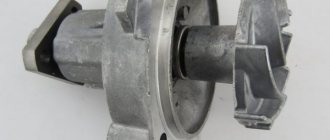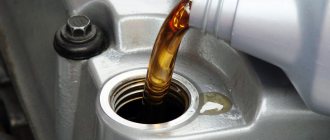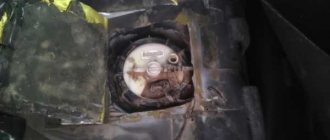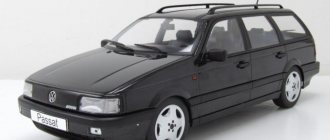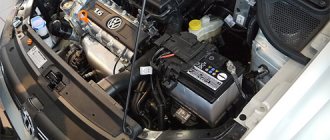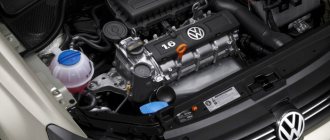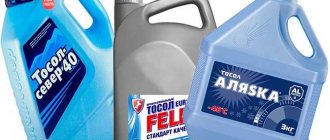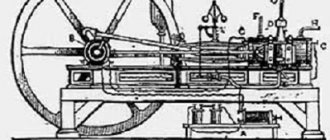The engine cooling pump or water pump is the central element of the engine cooling system, ensuring constant circulation of coolant (antifreeze) in the small and large circulation circuits.
You can select and buy a pump here.
Figure 1 shows a schematic diagram of the engine cooling system. The pump (shown in green), due to the centrifugal force generated by the rotation of the impeller, pumps antifreeze into the channels of the engine cooling jacket. Passing through the channels, the antifreeze heats up, and when it reaches a certain temperature (for example, 82 degrees), the thermostat opens. Hot antifreeze enters the cooling radiator where it is cooled by the incoming air flow. The cooled antifreeze returns to the pump and is again pumped into the engine cooling channels.
Fig.1
Figure 2 shows the pump structure. The pump body is indicated in orange. The body is made of aluminum or cast iron. A shaft is fixed in the pump body using ball bearings (indicated in lilac). The shaft transmits torque from the pump belt pulley to the pump impeller. To ensure the tightness of the pump, a pump seal is installed on its shaft (indicated in yellow and green). The blue color in the figure indicates the pump impeller. The impeller is made of steel, cast iron or plastic.
Fig.2
Pump seal leaking.
There is a drainage hole on the pump body. If the seal of the pump seal is broken, antifreeze begins to flow into the internal space of the pump and flow out of the drainage hole (Fig. 3 and Fig. 4). The causes of damage to the pump seal are various. The oil seal may wear out during operation (original pumps last 200-300 thousand km). The oil seal can be damaged by mechanical particles (scale, sand, metal particles). Damage to the seal can be caused by a sudden change in temperature. Chemically aggressive substances can also cause damage to the seal. To prevent damage to the pump, it is necessary to promptly replace the coolant using high-quality antifreeze. Do not add large volumes of cold antifreeze to a hot engine, as this can lead to thermal damage to the pump seal.
Fig.3
Fig.4
What does the pump do?
» The water pump is an integral part of the cooling system of the internal combustion engine of any vehicle. The design of this unit is quite simple, and the purpose is clear from the name itself. The engine cooling pump, or water pump, is the part of the system that cools a hot engine. Without the system working properly or components failing, motors overheat and bring a lot of trouble to their owners.
The water pump or engine cooling system pump circulates fluid through the power unit to the cooling elements, thereby ensuring a constant operating temperature inside the structure. Before proceeding directly to the analysis of the main elements of the water pump, it is worth understanding the overall engine cooling system. To do this, it is worth considering what elements are included in it, and how the coolant circulation process takes place:
- Water pump.
- Thermostat.
- Radiator.
- Set of pipes.
- Water jacket inside the engine.
- Expansion tank.
- Drain taps and plugs.
An expanded range of engine cooling system parts also includes: heater radiator and heater pipes.
The engine cooling pump circulates coolant throughout the system.
Thus, it is worth understanding that, like any pump, it consists of parts, namely:
- Bearing.
- Pulley (on most models, a removable part of the pump).
- Sealing ring.
- Clamping spring (on older models of domestic cars).
- Frame.
- Drive shaft.
- Impeller.
How does the product work? Using a drive belt that is hooked onto a pulley, the system is put into operation.
The movement from the pulley is transmitted to the shaft, and then to the impeller, which then circulates the coolant.
Do you experience any extraneous noise while driving?
It is worth noting that the higher the crankshaft speed, the more the engine heats up, so the crankshaft pulley is paired with a belt with a water pump pulley.
Coolant leaking? It's time to look under the hood and check the condition of the coolant pump. Where can I find it, and what malfunctions are typical for this part? The cooling system pump (pump) performs an important function - cooling the car’s engine. During operation of the vehicle, the power unit heats up, and to prevent overheating, the pump, under the influence of the timing belt, produces forced circulation of coolant in the system.
Coolant flows to the water pump from the lower radiator reservoir. The fluid leaving the pump passes through the cylinder block and cylinder heads, then into the radiator and eventually back to the pump.
Without an engine cooling system, its normal and uninterrupted operation is impossible. A malfunction of the cooling system pump leads to boiling of the coolant and, accordingly, engine failure. A faulty pump can cause irreversible damage to the engine. The pump is an aluminum or steel housing, inside of which there is an impeller (impeller) located on a shaft with a pulley. Inside the structure there are special channels designed for draining and supplying coolant.
On the drive shaft there is an impeller, which rotates and sets the coolant in motion.
At the other end of the shaft there is a pulley. The body and impeller are made by casting magnesium or aluminum alloys; there are plastic impellers. The cooling system pump is located in the front part of the cylinder block. You can understand that the pump has exhausted its service life by the following signs:
- drops of coolant are visible under the vehicle;
- extraneous noises (knocking or crunching) appeared when driving the car;
- the readings of the sensor that determines the coolant temperature are in the red sector;
- The coolant level in the expansion tank has dropped.
- the smell of coolant is clearly felt in the car interior;
When buying a cheap pump or a counterfeit of a well-known brand, there is a high probability of its rapid wear.
Antifreeze leaking through the pump body.
Sometimes antifreeze leaks along the back wall of the pump at the junction with the back cover of the pump (Fig. 5 and Fig. 6). Basically, this malfunction occurs immediately after installing the pump. The cause of this breakdown is a leaky connection between the pump body and the back cover. This can be caused by foreign particles entering the joint, uneven (with gaps) application of sealant to the mounting surfaces, insufficient or uneven tightening of the mounting bolts, or the use of sealant simultaneously with a rubber O-ring.
To prevent this type of breakdown, you need to carry out vehicle maintenance only by qualified specialists.
Fig.5
Fig.6
Water pump design
The appearance of water pumps may be different (the design features of power plants from different manufacturers affect them), but they are all structurally the same and consist of:
- frame;
- axis;
- pulley or gear;
- impeller;
- stuffing box;
- bearings.
Frame
The housing is a load-bearing element and contains all of the listed components, except for the impeller and pulley, which are located on the outer sides. The body is most often made of aluminum. It is also used to attach the pump to the cylinder block. To ensure tightness at the junction of the housing and the motor, a gasket is installed between them.
To prevent antifreeze and moisture from accumulating in the area where the bearings are located, a drainage hole is made in the housing.
Axle, bearings, oil seal
Inside the case there is a steel axis mounted on two bearings, which ensures ease of rotation. The axle is usually made of steel, which provides high strength.
The bearings are sealed, meaning there is no access to them. They are lubricated using the supplied lubricant, which should be enough for the entire service life of the pump. But on some old trucks, there was a grease nipple in the body, so their bearings could be lubricated.
Video: Selecting a Pump. Pump LUZAR.
To prevent contact of the working fluid with the bearings, a sealing rubber element - an oil seal - is installed on the impeller side. Without it, antifreeze would get into the bearing operating area, which would lead to their rapid wear.
Pulley, impeller
The pulley or gear is the element that receives the force from the crankshaft. The pulley is used on cars in which the gas distribution mechanism is driven by a chain drive. Because of this design solution, it was not possible to organize the transmission of force to the pump by a chain. Therefore, to ensure rotation of the pump, a separate belt drive is used, which can additionally provide operation of other engine attachments - power steering pump, compressor, etc.
In cars in which the timing drive is provided by a toothed belt, it is also used to ensure the operation of the pump. That is, one belt engages both the timing belt and the pump. And so that there are no losses due to slipping when transmitting force, a gear is used as a drive element on the pump.
A pulley or gear is rigidly connected to an axle. For this, either a keyed connection or a bolted connection is used.
Noise when the pump is running.
When the pump shaft bearing wears out, noise occurs when the pump operates; with severe wear, shaft beating occurs; in extreme cases, the shaft may become misaligned relative to the pump body and become jammed (Fig. 7). Preventing damage to the pump bearing is to avoid excessive tension on the pump drive belt. It is also necessary to promptly replace the coolant and monitor the condition of the parts associated with the pump (thermal coupling).
Fig.7
What is a pump for in a car and how does it work?
The engine cooling system of any car has its own pump (in jargon - a pump). The element is quite reliable in operation, but requires supervision, since it plays an important role in the operation of the power unit. If a part breaks, the car will not be able to continue its journey. Hence, the purpose of this publication is to explain to inexperienced car enthusiasts what a pump is and how it functions.
Purpose and location of the element
The coolant is unable to circulate through the radiator and engine water jacket on its own. To encourage it to move, the system uses a pumping device - a pump, whose impeller (impeller) is rotated by a belt drive from the crankshaft. Depending on the design of the vehicle, the pump is located in the following places:
- In front-wheel drive cars, the element is located on the right side of the engine (if viewed in the direction of travel). Since the pump is part of the timing belt drive, protected by a cover, it cannot be seen from the outside.
- On vehicles equipped with rear-wheel drive, the pump is located at the front of the power unit and is driven by the timing belt or alternator drive.
A pump built into the engine design is needed for effective cooling of the block and cylinder head by creating forced circulation. Thanks to it, the flow of antifreeze passes through 2 radiators - the main one and the cabin one, where it gives off the lion's share of the heat.
Can the part be repaired?
The vast majority of cars are equipped with a non-repairable engine cooling pump. If desired, the car enthusiast can remove and disassemble it, but it is unlikely that it will be possible to change the oil seal and bearing, since these spare parts are not on sale. The exception is the classic Zhiguli models and a number of other car models for which repair kits are produced.
Reference. Spare parts of repair kits are not original and do not shine with quality. The service life of the pump after repair will be halved compared to the factory spare part.
It is customary to replace water pumps as an assembly. Moreover, the replacement itself is not very difficult - we cleaned the seat of the old gasket, applied sealant and screwed on the new pump. The most labor-intensive part of the procedure is disassembling the timing belt assembly with marking, removing pulleys and filling/draining the cooling system. If you do not have enough experience in car repairs, it is better to entrust the work to the service station technicians.
water pump
, also known as a car engine water pump, is a pump that creates forced circulation of coolant in the internal combustion engine cooling system.
The water pump
is intended to organize the circulation of antifreeze or other composition in the cooling system. A malfunction of the pump leads to a serious disruption of the internal thermal regime of the engine, which is why it “boils” quite quickly.
This cannot be allowed to happen, so to make sure that the engine pump is working, you need to periodically listen and inspect the motor in order to repair or replace the failed unit in time.
Water pump repair
The engine pump is a repairable, dismountable unit. Here it is possible to replace both the entire mechanism and its individual elements, such as bearings. The fact that a car pump does not have to be completely replaced is good news, since this can significantly reduce the cost of repairs. True, access to this unit for partial or complete disassembly can be difficult. So, in some car models, this requires partially unscrewing the engine mounts, working from below from the inspection hole. Very often, the pump is replaced every second time the timing belt/chain is replaced, but if symptoms of a malfunction occur, the water pump is replaced even earlier, it all depends on the quality of the part and the level of work performed during the previous change of the timing drive and the part itself.

